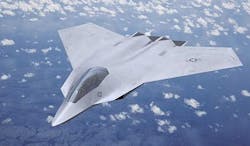Lockheed Martin eyes next-generation power and thermal management for combat aircraft
Officials of the U.S. Air Force Research Laboratory at Wright-Patterson Air Force Base, Ohio, announced a seven-year contract Friday, worth as much as $409 million, to the Lockheed Martin Aeronautics segment in Fort Worth, Texas, for the Next Generation Thermal, Power, and Controls (NGT-PAC) program.
Lockheed Martin engineers will conduct research to prove the technological feasibility of new kinds of thermal, power, and controls components and architectures using existing airframe and engine designs as test beds. Lockheed Aeronautics is the designer and manufacturer of the F-35 and F-22 combat aircraft.
Next-generation fighter aircraft will require an unprecedented level of advanced capabilities for air superiority in contested environments, Air Force researchers say. These capabilities will include advanced electronic attack, high-power laser, and future low-observability features.
Related: Air Force wants new electronics thermal management techniques for fighter aircraft
These advanced technologies are expected to require as much as 10 times the power levels than current tactical systems, Air Force experts say.
These power system demands present electrical and thermal challenges aboard aircraft -- especially in the presence of composite aircraft skins, high-efficiency engines, and embedded vehicle systems. Lockheed Martin experts will try to better understand the challenges and opportunities of, and advance the state of the art in, next-generation aircraft thermal, power, and controls.
Lockheed Martin researchers will focus on two areas: aircraft engines and airframes. Air Force officials may add other contractors to this project, which focuses on developing revolutionary aircraft power, thermal, and controls technologies.
On this contract Lockheed Martin will do the work in Fort Worth, Texas, and should be finished by July 2024. For more information contact Lockheed Martin Aeronautics online at www.lockheedmartin.com/us/aeronautics.html, or the Air Force Research Laboratory at www.wpafb.af.mil/afrl.
Learn more: search the Aerospace & Defense Buyer's Guide for companies, new products, press releases, and videos
